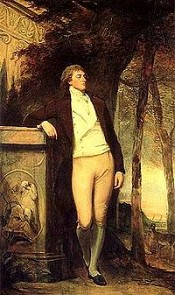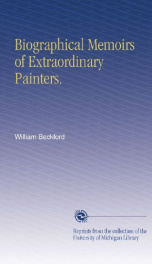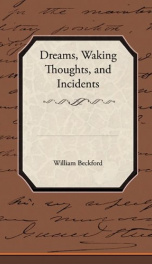Beckford William

William Thomas Beckford (1 October 1760 – 2 May 1844), usually known as William Beckford, was an English novelist, a profligate and consummately knowledgable art collector and patron of works of decorative art, a critic, travel writer and sometime politician, reputed to be the richest commoner in England. He was Member of Parliament for Wells from 1784 to 1790[1], for Hindon from 1790 to 1795 and 1806 to 1820.[2] He is remembered as the author of the Gothic novel Vathek, the builder of the remarkable lost Fonthill Abbey and Lansdown Tower ("Beckford's Tower"), Bath, and especially for his art collection. Beckford was born in the family's London home at 22 Soho Square.[3] At the age of ten, he inherited a fortune consisting of £1 million in cash, land at Fonthill (including the Palladian mansion Fonthill Splendens) in Wiltshire, and several sugar plantations in Jamaica from his father William Beckford, usually referred to as "Alderman Beckford", who had been twice a Lord Mayor of the City of London. This allowed him to indulge his interest in art and architecture, as well as writing. He was briefly trained in music by Wolfgang Amadeus Mozart, but his drawing master Alexander Cozens had a much greater influence on him, and Beckford continued to correspond with him for some years until their falling-out. Despite his wealth and education, Beckford was ostracized from polite English society and his hopes for a peerage were dashed as a result of the scandal caused by his love affair with a youth, William Courtenay, later 9th Earl of Devon, and its exposure in the papers by Lord Loughborough, the boy's uncle and a bitter political enemy of Beckford's tutor, Lord Chancellor Thurlow.[4] Beckford had fallen in love with the boy in 1779. To silence ensuing rumors of homosexuality, he was pressed by his family into marriage with Lady Margaret Gordon, daughter of the fourth Earl of Aboyne, which took place on May 5, 1783. The following year, however, the scandal of his affair with Courtenay reached such proportions (possibly as a result of the exaggerations and fabrications by Loughborough) that the two were forced apart and Beckford chose exile in the company of his wife, whom he grew to love deeply, but who died in childbirth at the age of 24.[5] Beckford's fame, however, rests as much upon his eccentric extravagances as a builder and collector as upon his literary efforts. In undertaking his buildings he managed to dissipate his fortune, which was estimated by his contemporaries to give him an income of £100,000 a year. The loss of his Jamaican sugar plantation to James Beckford Wildman was particularly costly. Only £80,000 of his capital remained at his death. Having studied under Sir William Chambers and Alexander Cozens, Beckford journeyed in Italy in 1782 and promptly wrote a book on his travels: Dreams, Waking Thoughts and Incidents (1783). Shortly afterward came his best-known work, the Gothic novel Vathek (1786), written originally in French; he boasted that it took a single sitting of three days and two nights, though there is reason to believe that this was a flight of his imagination. Vathek is an impressive work, full of fantastic and magnificent conceptions, rising occasionally to sublimity. His other principal writings were Memoirs of Extraordinary Painters (1780), a satirical work; and Letters from Italy with Sketches of Spain and Portugal (1835), full of brilliant descriptions of scenes and manners. In 1793 he visited Portugal, where he settled for a period. Beckford was a compulsive and restless collector, who also frequently sold works, sometimes later repurchasing them. In terms of today's taste his collection was most notable for its many Italian Quattrocento paintings, then little collected and cheap. Despite his interest in Romantic medievalism, he owned few medieval works, though many from the Renaissance. He was also interested in showy Asian objets d'art such as Mughal hardstone carvings. But though he avoided the souped-up classical marbles typical of the well-educated English collector, much of his collection was of 18th century French furniture and decorative arts, then enormously highly priced compared to paintings by modern standards. He bought an isolated Turner in 1800, when the artist was only 25 (The Fifth Plague of Egypt, £157.10s), and in 1828 William Blake's drawings for Gray's Elegy,[6] as well as several works by Richard Parkes Bonington, but in general he preferred older works. By 1822 he was short of funds in debt and put Fonthill Abbey up for sale, for which 72,000 copies of Christie's illustrated catalogue were sold at a guinea apiece; the pre-sale view filled every farmhouse in the neighborhood with visitors from London.[7] Fonthill, with part of his collection was sold before the sale for £330,000 to John Farqhuar, who had made a fortune selling gunpowder in India.[8] Farqhuar at once auctioned the art and furnishings in the "Fonthill sale" of 1823, at which Beckford and his son-in-law the Duke of Hamilton were heavy purchasers, often buying items more cheaply than the first price Beckford had paid, as the market was somewhat depressed. What remained of the collection, as it was maintained and added to at Lansdown Tower, amounting virtually to a second collection, was inherited by the Dukes of Hamilton, and much of that was dispersed in the great "Hamilton Palace sale" of 1882, one of the major sales of the century. The Fonthill sale was the subject of William Hazlitt's scathing review of Beckford's taste for "idle rarities and curiosities or mechanical skill", for fine bindings, bijouterie and highly-finished paintings, "the quintessence and rectified spirit of still-life", republished in Hazlitt's Sketches of the Picture Galleries of England (1824),[9] and richly demonstrating his own prejudices.[10] Beckford pieces are now in museums all over the world.[11] Hazlitt was unaware that the sale had been salted with many lots inserted by Phillips the auctioneer, that had never passed Beckford's muster: "I would not disgrace my house by Chinese furniture," he remarked later in life. "Horace Walpole would not have suffered it in his toyshop at Strawberry Hill".[12] Now in National Gallery, London: Other collections: 'The opportunity to purchase the complete library of Edward Gibbon gave Beckford the basis for his own library, and James Wyatt built Fonthill Abbey in which to house this and the owner's art collection. Lord Nelson visited Fonthill Abbey with the Hamiltons in 1800. The house was completed in 1807. Beckford entered parliament as member for Wells and later for Hindon, quitting by taking the Chiltern Hundreds; but he lived mostly in seclusion, spending much of his father's wealth without adding to it. In 1822 he sold Fonthill, and a large part of his art collection, to John Farquhar for £330,000 and moved to Bath, where he bought No. 20 Lansdown Crescent and No. 1 Lansdown Place West, joining them with a one-storey arch thrown across a driveway. In 1836 he also bought Nos. 18 and 19 Lansdown Crescent (leaving No 18 empty to ensure peace and quiet). Most of Fonthill Abbey collapsed under the weight of its poorly-built tower the night of December 21, 1825. The remains of the house were slowly removed, leaving only a fragment, which exists today as a private home. He spent his later years at Lansdown Crescent, and he commissioned architect Henry Goodridge to design a spectacular folly on Lansdown Hill: Lansdown Tower, now known as Beckford's Tower, in which he kept many of his treasures. It is now owned by the Bath Preservation Trust and operated by the Beckford Tower Trust as a museum to Beckford; it is also available for hire as a holiday home from the Landmark Trust. The museum contains numerous engravings, chromolithographs of its original interior and a great deal of information about Beckford, in addition to objects related to Beckford and his life including signs and etched glasses advertising "Beckford Blend Scotch Whisky" and the skull and femur of a horse, believed to be Beckford's. After his death at Lansdown Crescent on 2 May 1844, aged 84, his body was laid in a sarcophagus placed on an artificial mound, as was the custom of Saxon kings from whom he claimed to be descended. Beckford had wished to be buried in the grounds of Landsdown Tower, but was instead interred at Bath Abbey cemetery in Lyncombe Vale on 11 May 1844. The Tower was sold to a local publican, who turned it into a beer garden. Eventually however it was bought back by the Beckfords' elder daughter, the Duchess of Hamilton, who gave the land around it to Walcot parish for consecration as a cemetery in 1848. This enabled Beckford to be re-buried near the Tower that he so loved. His self-designed tomb — a massive sarcophagus of pink polished granite with bronze armorial plaques — now stands on a hillock in the centre of an oval ditch. On one side of his tomb is a quotation from Vathek: "Enjoying humbly the most precious gift of heaven to man - Hope"; and on another these lines from his poem, A Prayer: "Eternal Power! Grant me, through obvious clouds one transient gleam Of thy bright essence in my dying hour." Goodridge designed a Byzantine entrance gateway to the cemetery, flanked by the bronze railings which had surrounded Beckford's original grave in Lyncombe Vale [30]. As a writer, Beckford is remembered for Vathek, of which the reception from every quarter may have satisfied his ambitions for a career in belles-lettres, and for his travel memoir, Italy: with some Sketches of Spain and Portugal. He followed Vathek with two parodies of current cultural fashions, the formulaic sentimental novel, in Modern Novel Writing, or, The Elegant Enthusiast (1796)[31] and Azemia, a satire on the Minerva Press novels.[32] and also published Biographical Memoirs of Extraordinary Painters (1824), a literary prank burlesquing serious biographical encyclopedias. Towards the end of his life he published collected travel letters, under the title Recollections of an Excursion to the Monasteries of Alcobaca and Batalha (1835), the memoir of a trip made in 1794. Beckford left two daughters, the youngest of whom (Susanna Euphemia) was married to Alexander Hamilton, 10th Duke of Hamilton, and inherited his collection. The eldest, Margaret Maria Elizabeth Beckford, married Lt-Gen. James Orde.[33]
do you like this author?
What readers are saying
What do you think? Write your own comment on this book!
write a commentWhat readers are saying
What do you think? Write your own comment on this author!
write a commentBook list

Shorter Novels,Eighteenth Century
The History of Rasselas,Prince of Abyssinia; The Castle of Otranto,a Gothic Story; Vathek,an Arabian Tale
Series:
Unknown
Year:
Unknown
Raiting:
3.5/5
Show more
add to favoritesadd In favorites

the history of the caliph vathek by william beckford
Series:
Unknown
Year:
Unknown
Raiting:
4.5/5
Show more
add to favoritesadd In favorites
Book list

Shorter Novels,Eighteenth Century
The History of Rasselas,Prince of Abyssinia; The Castle of Otranto,a Gothic Story; Vathek,an Arabian Tale
Series:
Unknown
Year:
Unknown
Raiting:
3.5/5
Show more
add to favoritesadd In favorites

the history of the caliph vathek by william beckford
Series:
Unknown
Year:
Unknown
Raiting:
4.5/5
Show more
add to favoritesadd In favorites

sailing directions for the north coast of france
Series:
Unknown
Year:
Unknown
Raiting:
3/5
Show more
add to favoritesadd In favorites

italy with sketches of spain and portugal volume 2
Series:
Unknown
Year:
Unknown
Raiting:
4/5
Show more
add to favoritesadd In favorites

biographical memoirs of extraordinary painters
Series:
Unknown
Year:
Unknown
Raiting:
4.5/5
This volume is produced from digital images created through the University of Michigan University Library's preservation reformatting program. The Library seeks to preserve the intellectual content of items in a manner that facilitates and promotes a variety of uses. The digital reformatting process results in an electronic version of the text that can both be accessed online and used to create new print copies. This book and thousands of others can be found in the digital collections of the University of Michigan Library. The University Library also understands and values the utility of print, and makes reprints available through its Scholarly Publishing Office.
Show more
add to favoritesadd In favorites

Dreams, Waking Thoughts, and Incidents
Series:
Unknown
Year:
Unknown
Raiting:
3.5/5
The sun set before I recovered my senses enough to discover plainly the variegated slopes near Canterbury waving with slender birch-trees and gilt with a profusion of broom. --This text refers to an alternate Paperback edition.
Show more
add to favoritesadd In favorites
What readers are saying
What do you think? Write your own comment on this author!
write a commentif you like Beckford William try:
readers also enjoyed
What readers are saying
What do you think? Write your own comment on this author!
write a commentGenre
if you like Beckford William try:
readers also enjoyed
Do you want to read a book that interests you? It’s EASY!
Create an account and send a request for reading to other users on the Webpage of the book!

